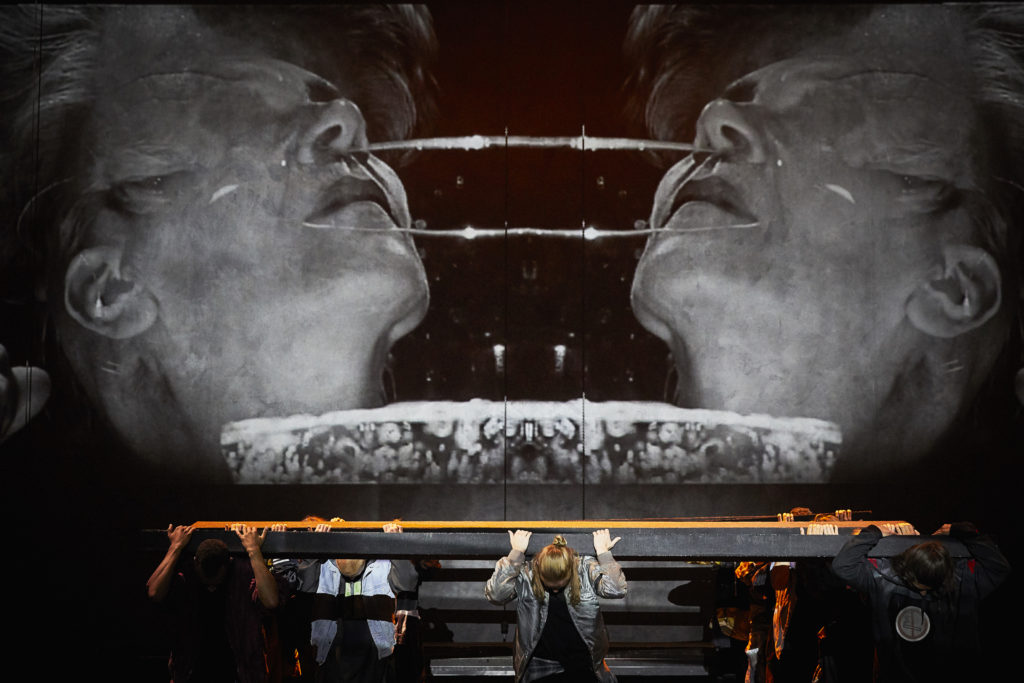Grensgeval (Borderline) A theatrical exploration of the refugee crisis.

Texte : Elfriede JELINEK –
Traduction Tom KLEIJN –
Mise en scène : Guy CASSIERS –
Chorégraphie : Maud LE PLADEC –
Scénographie, costumes : Tim VAN STEENBERGEN –
Lumière : Fabiana PICCIOLI –
Vidéo : Frederik JASSOGNE –
Son : Diederik DE COCK –
Dans le cadre du 71e Festival d’Avignon –
Lieu : Parc des Expositions –
Ville : Avignon –
Photo : Christophe RAYNAUD DE LAGE –
Grensgeval (Borderline).Based on Les Suppliants by Elfriede Jelinek.
Directed by Guy Cassiers, choreography by Maud Le Pladec, A Toneelhuis, Antwerp production.
Migration, refugee crisis and crossing borders are among the most pressing political, social and economic issues of today’s Europe. The situation is alarming and confusing both on the level of everyday life and politically, with many people in power trying to manipulate public opinion against refugees. Politically aware artists are actively engaged in searching to contribute to their audiences’ better understanding of the new world. They seek appropriate artistic language to discuss atrocities that refugees experience and to speak to their spectators’ compassion.
Guy Cassiers is one of these engaged artists. An artistic director of the Toneelhuis in Antwerp, Cassiers has been looking into the issues of migration for the past several seasons. He not only focusses his programing on this topic but also creates events aimed at educating the subscribers to his theatre about the new European conditions, seeking to engage refugees to be more actively involved in the cultural life of Antwerp.
Grensgeval (Borderline) is one of Cassiers’s latest works. It reflects his political program and theatre philosophy : to make encounters between the stage and the audience the space of historical reflection. In his previous works, Cassiers looked into other dark histories of Europe, including World War II and specifically the Holocaust. For Avignon 2017, he also created a play Le sec et l’humide, based on the novel by Jonathan Littell, dedicated to exploring the language of fascism as ordinary evil.
Grensgeval continues this exploration. Inspired by Elfriede Jelinek’s 2013-2015 play The Supplicants (in the English translation), it offers a theatrical attempt to bring the impossible even closer. Jelinek’s text is written more as a chant than a dramatic dialogue, with no characters or dramatic actions. Cassiers’s staging turns this text into a theatrical requiem, with four narrators speaking the lines and sixteen dancers (the students of The Royal Conservatoire of Antwerp) enacting movement. The genre of this production is quite difficult to determine: it includes elements of modern dance, poetry recitation, dance-teatr, with some video projections at the beginning.
The action consists of three parts reflecting the tripartite structure of the exilic journey, such as departure, arrival and settlement. These parts, as Cassiers explains, also correspond to the Stations of the Cross, referring to the thirteen iconographic images depicting all the steps of Jesus’ crucifixion and his dying on the cross.
The action, however, is derived of emotion. Interested in experimenting with potentials of theatrical sound and inspired by the chant-like quality of Jelinek’s text, Cassiers separates voices from bodies, creating a type of out-of-body experience as reported by the refugees-survivors. The narrators speak Jelinek’s lines in monotonous if not lifeless voices; the dancers movements evoke different experiences and metaphors of the exilic flight.
In the first part, the faces of the narrators are projected in black-white on the back wall; whereas the dancers conjure up images of crossing the sea in a boat. The narrators’ faces are out focus, exaggerated and blurred, detached from their bodies.
In the second part, the narrators begin to mingle with the dancers, as if the voices and the bodies had found a way to come back together, suggesting the triumphs and losses of arrival.
In the third part, the narrators get lost among the dancers. They speak the lines labouring their way out of the crippled bodies which cling to them. This third part is the most visually evocative because the dancers, together , create a series of tableaux-vivantes evocative of Christian iconography, such as The Descent from the Cross, with the figures of distorted bodies climbing out of Hell, inspired by the paintings of Hieronymus Bosch.
Overall, however, this production was rather a disappointment. Despite its strong philosophical premise and promising background material, including Jelinek’s hypnotic text as well as the energy of young dancers on stage, Grensgeval felt more like a lost opportunity. Perhaps, it fell victim of the director’s over-thinking the impossibility of bringing together the rupture between the refugees’ experiences in life and their theatrical representation, and thus his desire to find the artistic tone suitable to tragedy not melodrama. As a result, the production turned into a series of beautiful but somewhat over-aestheticized moments, which did not make a coherent or energetic theatrical picture, something that the urgency of the refugee crisis dictates.
In Dutch with French subtitles. Cast: With Avec Katelijne Damen, Abke Haring, Han Kerckhoffs, Lukas Smolders as narrators and the dancers: Samuel Baidoo, Machias Bosschaerts, Pieter Desmet, Sarah Fife, Berta Fornell Serrat, Julia Godina Llorens, Aki Iwamoto, Daan Jaarsveld, Levente Lukacs, Hernan Manchebo Martinez, Alexa Moya Panksep, Marcus Alexander Roydes, Meike Stevens, Pauline van Nuffel, Sandrine Wouters, Bianca Zueneli.
July 18 -23, 2017 Parc des expositions – Avignon